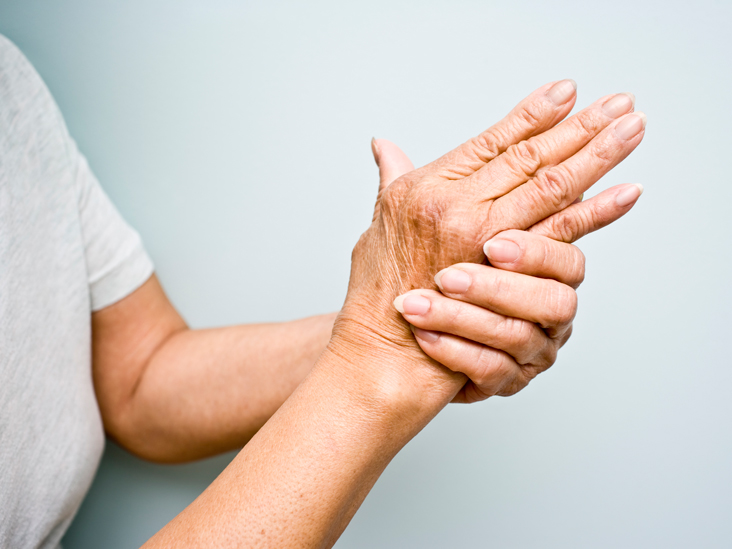8 Signs and Symptoms of Rheumatoid Arthritis
April 9 2018
Rheumatoid arthritis is a serious autoimmune disease that attacks the joints and other body parts.
But RA can be tough to diagnose. Symptoms can mimic other illnesses, or they may flare, then fade, only to flare again somewhere else. Lab tests aren’t perfect—you can test negative for RA factors and still have it. And X-rays don’t show signs until later on.
Here are some tricky rheumatoid arthritis symptoms and hints that they’re due to RA and not some other condition.
Hard to heal injuries
It’s possible to think you have an injury—such as a sprained ankle that doesn’t seem to heal—when the symptoms are actually due to RA.
This is more common in younger people, says Lisa A. Mandl, MD, MPH, assistant attending rheumatologist at Hospital for Special Surgery in New York City.
One day a patient is playing soccer and the next day her knee is swollen, she says. “I have seen people who have had two arthroscopic surgeries and extensive physical therapy in their knee and they have rheumatoid arthritis.”
Numbness or tingling in the hands
One symptom of rheumatoid arthritis is carpal tunnel syndrome, which is marked by tingling in the wrist and hands. Dr. Mandl says the sensation is similar to the feeling you get when you hit your funny bone.
What happens is that the swelling in the arm compresses the nerves going into the hands. The sensation is often worse at night.
If you go to a doctor with these symptoms and don’t have (or tell him or her about) other RA symptoms, you may be diagnosed only with carpal tunnel syndrome.
Foot trouble
One area in which people often have RA-related pain or inflammation is the forefoot.
Women often stop wearing heels and head to a podiatrist due to the pain.
Some people with RA may also develop pain in the heel because of plantar fasciitis, a common foot disorder caused by swelling of the tissue at the bottom of the foot, near the heel.
Eye problems
People with RA are also at risk for Sjogren’s syndrome, an autoimmune disorder that can cause dryness of the eyes, mouth, nose, throat, or skin due to inflammation that stops glands from releasing moisture, says Dr Mandl.
This can happen even in the early stages of RA, but it’s unlikely to be the only symptom.
Most people with dry eyes head to an eye doctor to find out the cause, but Dr Mandl recommends telling your doctor—even an eye doctor or other specialists—about additional symptoms you’re having in any part of the body.
Pairs of achy joints
One of the most predominant symptoms of rheumatoid arthritis is aching in the joints. People often think their pain is due to overexertion or osteoarthritis, the type of arthritis common in old age.
This achiness can also be misdiagnosed as fibromyalgia or chronic fatigue syndrome (fatigue is another symptom of RA).
RA joint pain is not fleeting; it usually lasts longer than a week. It can also be symmetrical, meaning both hands, feet, knees, or ankles will be affected at the same time.
Morning stiffness
Another characteristic of rheumatoid arthritis is stiffness in the joints in the morning.
Again, this is also a common problem in osteoarthritis, which can cause pain after long periods of inactivity, like sleeping.
The difference between the two is that osteoarthritis pain usually subsides in about a half hour. Stiffness from rheumatoid arthritis will last much longer, possibly for a good chunk of the day.
The right kind of exercise can help alleviate stiffness for people with RA and osteoarthritis pain.
Locked joints
People with RA can sometimes experience locked joints, particularly in the knees and elbows. This happens because there’s so much swelling of the tendons around the joint, the joint cannot bend. It can lead to cysts behind the knee that can puff out and inhibit motion.
The symptom can be mistaken for a meniscus tear, a knee joint injury that’s common in sports, and which can also lead to cysts.
Nodules
These are firm lumps that grow under the skin near the affected joints. They often appear at the back of the elbows, and sometimes people get them in the eyes.
They’re more common in people who have advanced rheumatoid arthritis, but occasionally show up earlier, says Dr Mandl.
The nodules can at times mimic gout, another form of arthritis.
Sourced from Health.

